Bartol Kašić facts for kids
Quick facts for kids
Bartol Kašić
|
|
|---|---|

Kašić bust in the Town of Pag
|
|
| Born | August 15, 1575 Pag, Republic of Venice (present-day Croatia)
|
| Died | December 28, 1650 (aged 75) Rome
|
| Other names | Bartul Kašić Bogdančić (signature) Pažanin ("of Pag", signature) |
| Citizenship | Republic of Ragusa, Republic of Venice |
| Education | Illyric College in Loreto Rome |
Bartol Kašić (born August 15, 1575 – died December 28, 1650) was an important Croatian priest and language expert. He was a member of the Jesuit order, which is a Catholic religious group. Kašić is famous for writing the very first grammar book for the Croatian language. He also translated the Bible and other important church texts into Croatian.
Contents
Life Story of Bartol Kašić
Bartol Kašić was born on August 15, 1575, on the island of Pag. This island is now part of Croatia. His father died when Bartol was very young. So, his uncle, Luka Bogdančić, who was a priest, helped raise him. His uncle also taught him how to read and write.
His Education and Early Career
After 1590, Bartol studied at the Illyric College in Loreto, Italy. This college was run by the Jesuits. He was a very talented and hardworking student. Because of this, he was sent to Rome in 1593 to continue his studies. In 1595, he officially joined the Jesuit order.
Kašić became a priest in 1606. He worked as a confessor (a priest who hears confessions) in St. Peter's Basilica in Rome. From 1609 to 1612, he lived in Dubrovnik, a city in Croatia.
Missions and Travels
In 1612 and 1613, Kašić went on a special mission. He dressed up as a merchant and traveled through parts of the Ottoman Empire. These areas are now Bosnia, Serbia, and Slavonia in Croatia. He reported his findings from these travels to the Pope.
From 1614 to 1618, he was a Croatian confessor in Loreto. He went on another mission in 1618 and 1619. Later in his life, he wrote about these journeys in a book about his own life. He lived in Dubrovnik again from 1620 to 1633. After that, he returned to Rome and stayed there for the rest of his life. He passed away on December 28, 1650.
Bartol Kašić's Language Work
Even when he was a student, Bartol Kašić started teaching Croatian at the Illyric Academy in Rome. This made him very interested in the Croatian language. By 1599, he created a Croatian-Italian dictionary. This dictionary is still kept as a handwritten book in Dubrovnik today.
Kašić grew up speaking the Chakavian dialect of Croatian. However, he chose to use the Shtokavian dialect for his important works. He did this because Shtokavian was the most common dialect spoken by many South Slavic people. He wanted his books to be understood by as many people as possible.
The First Croatian Grammar Book
The Jesuits wanted to teach Christians in the Ottoman Empire in their local language. They needed a good textbook for teaching Croats. So, Kašić wrote and published Institutionum linguae illyricae libri duo in Rome in 1604. The title means "The Structure of the Illyrian Language in Two Books." This was the very first grammar book for a Slavic language.
This grammar book was almost 200 pages long. It explained the basic rules of Croatian and described how Croatian words change forms (called morphology). The language in the book was mostly Shtokavian, but it also had some Chakavian parts.
Translating the Bible into Croatian
In 1622, Kašić began translating the New Testament into the local Croatian language. He chose the Shtokavian dialect spoken in Dubrovnik for this work. By 1625, he was in charge of translating the entire Bible.
He finished the full translation in 1633 and sent it to Rome to get permission to print it. However, he faced problems because some Croatians did not want the Bible translated into the common language. In the end, his translation was not allowed to be printed.
Translating the Bible into local languages was very important for creating standard languages for many nations. Because Kašić's translation was banned, some experts have called it "the greatest disaster in the history of Croatian." Luckily, the handwritten copies of his translation were saved. They were finally published in 2000, with helpful notes from experts.
Kašić's translation showed amazing language skills. For example, the famous King James Version of the Bible in English was published in 1611. It has about 12,143 different words. Kašić's Croatian translation, even though it was not fully complete, had around 20,000 different words! This is more than the English version and even more than the original Bible.
The Roman Rite Book
Kašić's most famous work was Ritual rimski ("Roman Rite"), published in 1640. This book was over 400 pages long. It was used by almost all Catholic areas in Croatia for their church services.
Kašić called the language he used in Ritual rimski "our language" or "Bosnian." He used the term "Bosnian" even though he was from a Chakavian-speaking area. He wanted to use a "common language" that most people could understand. This was a version of Shtokavian that was spoken by many people who spoke Serbo-Croatian.
Main Works by Bartol Kašić
- Razlika skladanja slovinska (Croatian-Italian dictionary), Rome, 1599
- Institutionum linguae illyricae libri duo (The Structure of the Illyrian (Croatian) Language in Two Books), Rome, 1604
- Perivoj od djevstva (Virginal Garden; a collection of stories about saints), 1625 and 1628
- Two catechisms (books of religious instruction)
- Spiritual play St Venefrida, written in 1627, published in 1938
- The Bible (translation), 1633 (published in 2000)
- Ritual rimski (Roman Rite), 1640
See also
 In Spanish: Bartol Kašić para niños
In Spanish: Bartol Kašić para niños



